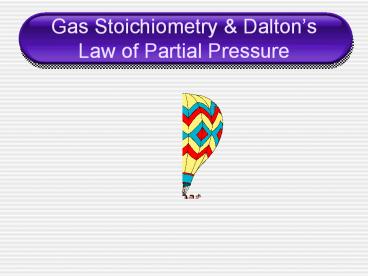Gas Stoichiometry - PowerPoint PPT Presentation
Title:
Gas Stoichiometry
Description:
Title: Slide 1 Author: a Last modified by: Stephanie & AJ LeGrone Created Date: 10/4/2005 10:40:16 PM Document presentation format: On-screen Show Other titles – PowerPoint PPT presentation
Number of Views:92
Avg rating:3.0/5.0
Title: Gas Stoichiometry
1
Gas Stoichiometry Daltons Law of Partial
Pressure
2
Gas Stoichiometry
- 2C4H10 13O2 ? 8 CO2 10 H2O
- Just like a mole to mole ratio, you can now have
a liter to liter ratio
3
Example
- C3H8 5O2 ? 3CO2 4 H2O
- What volume of oxygen gas is needed for the
complete combustion of 4.00 L C3H8?
4
Another Example
- How many g of CaH2 are required to generate 25.0
L of H2 at STP? - CaH2 2H2O ? Ca(OH)2 2H2
5
What if you are NOT at STP?
- If you are not at STP, you MUST use your
equations - You MUST look to make sure you are using the
right units (including the right gas)
6
Example
- N2 3H2 ? 2NH3
- If 5.00 L of N2 react completely at 3.00 atm and
298 K, how many grams of ammonia are produced? - You cannot use straight stoichiometry, but you
can go from L of one thing to L of another any
time
7
Daltons Law of Partial Pressure
- The total pressure of a mixture of gases the
sum of the pressures that each gas would exert if
present alone. - PT P1 P2 P3
- Also,
- nT n1 n2 n3
8
Daltons Law of Partial Pressure
- PTV (nT)RT
- P1V (n1)RT
9
Example
- A gaseous mixture is made from 6.00 g O2 and 9.00
g CH4 in a 15.0 L vessel at 273 K. What is the
partial pressure of each gas?
10
Example
What would be the total pressure?
11
Try this example
- What is the total pressure exerted by a mixture
of 2.00 g of hydrogen gas ans 8.00 g of nitrogen
gas at 273 K in a 10.0 L vessel?
12
Collecting Gases Over Water
- In chemistry it is often necessary to determine
the number of moles of a gas generated in a
chemical reaction. - We do this by water displacement
13
Total Pressure
- P T P gas P water vapor
- The pressure of the water vapor can be looked up
in a chart in appendix B
14
Example
- A sample of KClO3 is partially decomposed
producing oxygen gas that is collected over
water. The total volume of gas that is collected
is 0.250 L at 26C and 765 torr (1atm 760 torr) - Question 1
- How many moles of oxygen were collected?
15
Example
16
Question 2
- Calculate the number of grams of KClO3 that were
actually decomposed
17
Another Example
- NH4NO2 ? N2 2H2O
- A sample of ammonium nitrite is decomposed and
511 ml of gas are collected over water at 26C
and 745 torr of total pressure. How many grams of
ammonium nitrite were decomposed?
18
Kinetic Molecular Theory of Gases
- Gases consist of large numbers of molecules that
are in continuous motion - The volume of all the molecules of a gas are
negligible compared to the total volume in which
the gas is contained - Attractive and repulsive forces between gases are
negligible
19
Kinetic Molecular Theory of Gases
- Energy can be transferred between molecules
during collisions, but the average kinetic energy
of the molecules does not change with time as
long as the temperature remains constant
(collisions are perfectly elastic) - The average kinetic energy of the molecules is
proportional to the absolute temperature. At any
given temperature the molecules of all gases have
the same average kinetic energy































